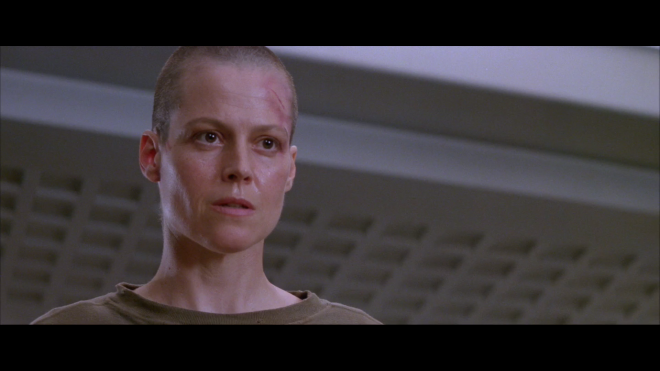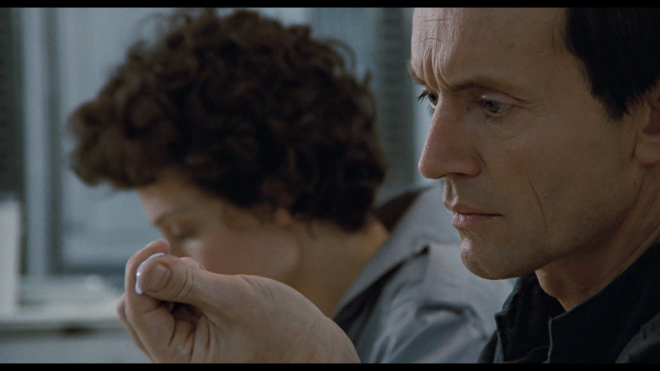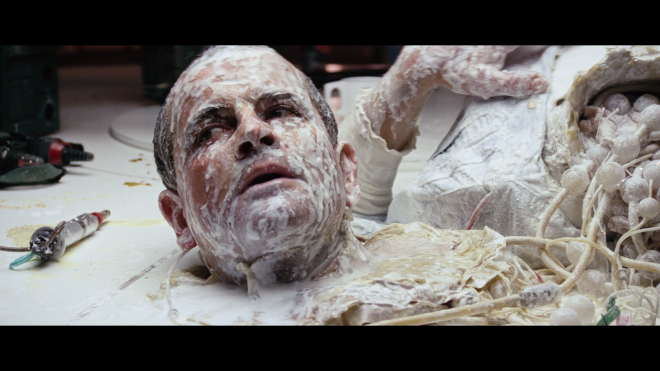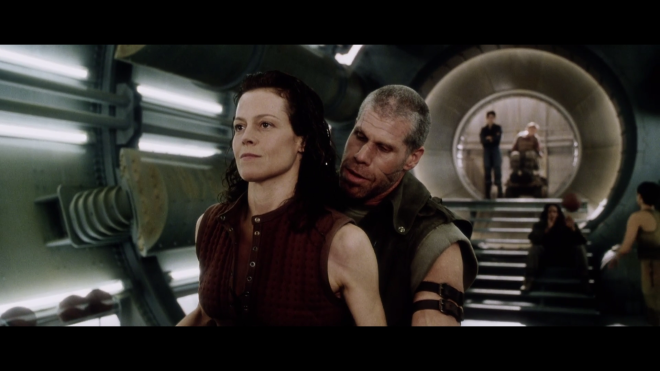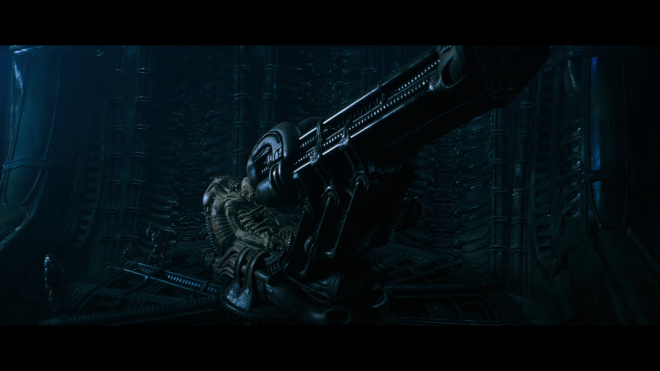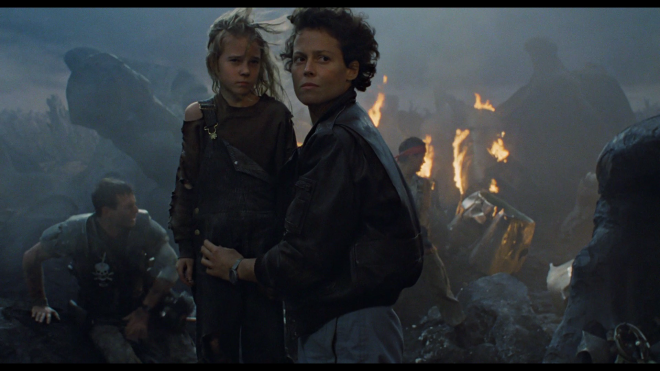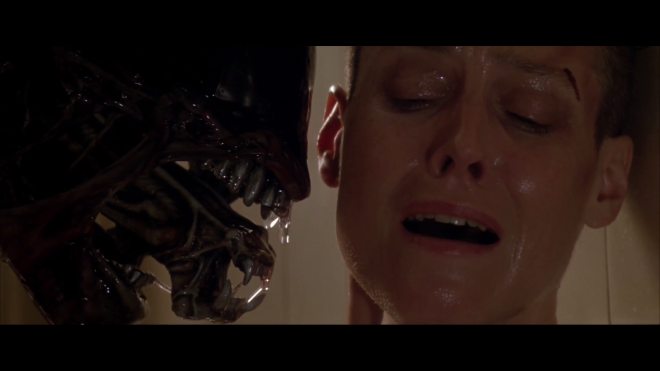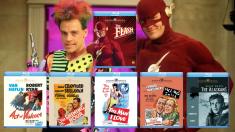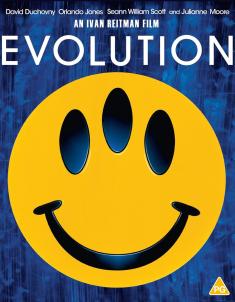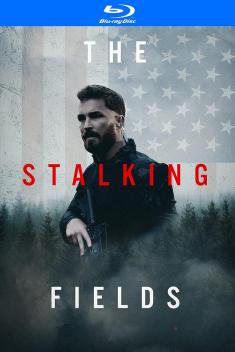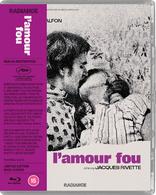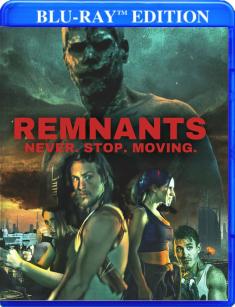Alien Anthology (Reissue)
Overview -
All four films in a six disc box set.
Storyline: Our Reviewer's Take

Alien (1979)
Alien is the groundbreaking sci-fi horror masterpiece that catapulted both Ridley Scott and Sigourney Weaver to super stardom. The film is a virtuoso ride of terror and suspense with subtle philosophical meditations and substance writhing beneath its simple story of survival. Released at a time when the public was still swooning over George Lucas's romantic space opera, Star Wars, the movie told audiences that the universe and its vast darkness remained a place to fear and dread. For those who have watched Howard Hawk's The Thing from Another World and Edward L. Cahn's It! The Terror from Beyond Space, the plot isn't entirely original, but its effectiveness is a testament to the skilled work of the actors, writers, and skilled filmmakers involved at each stage of production. Most importantly, the film sprang from the masterly vision of Ridley Scott.
In the opening shots, the commercial towing spaceship Nostromo moves across the screen — from top to bottom — as if flying above us, intimating the same opening from Lucas's film, but Scott quickly abolishes the similarities and reveals an ugly, bizarre-looking structure floating in outer space, nothing like the sort we'd immediately associate with a science-fiction adventure. Then we move through the damp, silent, grungy halls of the ship and into the control room, where the electronic beeps and chimes of computers are intently watched by an empty helmet. By the time we're finally introduced to the cast, awakening from what can be described as a kind of embryonic sleep, the metallic stillness of the spacecraft has become suffocating and oppressively confining. Once threatened by the alien creature, these tight, enclosed areas are used to incredible effect, creating tension and suspense through space alone.
Ridley Scott shows he is a patient director, first establishing an ominous and foreboding atmosphere, biding his time before characters are forced to survive a ravenous and brutal monster. He is, of course, assisted by an excellent script by Ronald Shusett and Dan O'Bannon (Return of the Living Dead), who is said to have pitched the story as "Jaws in space." And like Spielberg's horror classic, Scott holds back from fully revealing his boogeyman. Even while it viciously kills the crew one by one, Scott gives viewers only glimpses of the hideous beast until the closing moments. Alien' is a well-constructed and ingenious movie with a great deal more to offer than frights, especially considering the fact that Ripley (Weaver) is our first female action hero. The narrative's underlying themes are ripe with imagery and symbolism of sexuality and politics.
Alien depicts a drab and uninspiring future where the struggles of the working class remain unresolved and continue to be problematic, a fact that engineers Parker (Yaphet Kotto) and Brett (Henry Dean Stanton) bring attention to. It's in this space of already existing conflict that Ripley battles for her identity as a strong female voice. Her endless clashes with Ash (Ian Holm) are telling of this aspect within the story. With H.R. Giger's sexually-charged design for the creature and the derelict spacecraft, this tension is brought to the forefront and her fight for self-awareness is made even more apparent. The chestburster scene with Kane (John Hurt) is literally a perverse and abnormal childbirth. The alien kills the men by penetrating their bodies, but it changes modes of attack with Lambert (Veronica Cartwright). Ripley only defeats the deviant monster when she finally removes her androgynous uniform to reveal (and even possible accept?) herself as a woman.
Of course, this depends on how one chooses to enjoy Ridley Scott's beautifully crafted vision of a terrifying future in space. The 2003 Director's Cut still preserves these same underlying themes of the horror classic. The differences between the two are very minor, except that the original theatrical version is about a minute longer. The newer cut introduces mostly deleted scenes, like a physical altercation involving the two women of the ship and Ripley discovering a cocooned Dallas (Tom Skeritt), which add little to the movie. The reason for one being shorter than the other is the result of giving the later edition a smoother narrative flow. Scott has stated in interviews that he favors the 1979 cut — that it's perfect the way it is. I agree with that sentiment. Alien (1979) is a horror masterpiece. (Movie Rating: 5/5)
Aliens (1986)
Hot off the success of The Terminator, James Cameron directed a follow-up to Ridley Scott's film and took the storyline in a slightly different direction. Making it completely his own, while still maintaining its roots as a direct sequel, Cameron steeped his plot with a heavy dose of action and adventure. In fact, Aliens pretty much raised the bar in that area, which is a striking contrast to the intense horror elements of the original. The movie is also vastly unique and distinct from the Star Trek and Star Wars movies many were cheering for at the time. Much like its predecessor seven years earlier, this sci-fi feature surprised audiences everywhere, using standard genre tropes and then defying them. Living up to its tagline, "This Time It's War," Aliens is a brash, bare-knuckle display of frenetic action and grandiose violence that, surprisingly, is just as good as Scott's film.
If the first movie can be described as "Jaws in space," as O'Bannon once did, then Cameron's sequel is essentially "Rambo in space." Instead of a commercial freighter crew battling one vicious monster, a gung-ho, trigger-happy Marine Corps will face off against an entire horde. Part of the excitement comes from watching the soldiers interact aboard the warship Sulaco, their aggressive and combative attitudes being a big focus of the first half. Led by the inexperienced Lt. Gorman (William Hope), the colonial marines refuse to show any fear or apprehension before landing on LV-426. They display a disregard for Ripley's caution and a lack of respect for the danger they're about to encounter. But both Ripley (Weaver) and the audience understand the seriousness, which creates tension and concern. Once they meet their enemy, in which most of the team is killed in a matter of minutes, the tune of those left is suddenly for survival rather than the seek-and-destroy attitude seen earlier.
What ultimately works best — that is, other than the exciting action — is Cameron carrying over and expanding on many of the same themes explored in Scott's amazing work of horror. In Aliens, the Weyland-Yutani Corporation is given a personhood through talking head Carter Burke (Paul Reiser), a guy who immediately rubs us the wrong way. Whereas the first film only mentions human life as expendable and preserving an alien specimen as priority, this follow-up now turns it into a focal point of soulless corporate greed. Amid all the death and chaos, the company seeks to protect its investment and sees potential profit in the biological weapons area. In this gloomy and miserable future, even the military has been privatized for further commercial opportunities. Ripley is once again forced to battle two types of monsters and helped by Corporal Hicks (Michael Biehn), Vasquez (Janette Goldstein) and Hudson (Bill Paxton).
By placing our tough heroine in the middle of this harsh reality, Cameron is also able to expand on Ripley's character as a strong female voice. Just as in the previous film, she is compelled to prove herself as a woman within a masculine society, which is in sharp contrast to Vasquez's just-one-of-the-boys appearance and posture. In introducing little Newt (Carrie Henn) to the storyline, Ripley takes on a larger, more powerful role, readily accepting a maternal place without leaving behind those characteristics we've already come to admire in her. Indeed, this new attribute of protecting the child — who later eventually calls her "mommy" — from the other violent, monstrous mother, makes her more of a determined and confident hero than the soldiers. Ripley's relationship with Hicks and Bishop (Lance Henriksen) shows a masculine presence that can live peacefully alongside her, listen to her, and work as equals.
And just as in Scott's horror masterpiece, Cameron's Aliens can be enjoyed on the intense action and suspense alone. But for someone like myself, it's these aspects and qualities of the film which make it a well-crafted classic of science fiction. The 1991 Special Edition cut of the movie retains this same feel, if not actually making it more apparent to viewers. Most of the extra seventeen minutes in fact seem to add depth and motivation to the Ripley character, such as an early scene with Burke where the two talk about her daughter. It is later mentioned during an intimate moment with Newt, and the idea provides weight to their emotional hug at the end. Other scenes are neither here nor there, information that fans can do without, like Newt's family discovering the alien spacecraft and Hudson's "state-of-the-art" speech. Either way, both cuts are equally enjoyable in my book, and the theatrical version is a classic sci-fi actioner with brains. (Movie Rating: 4.5/5)
Alien³ (1992)
With two amazing and highly praised films already mounting a strong following, a third follow-up sounded like a great idea at the time. But the movie was instead confronted by challenges, expectations, and controversy. From the beginning, Alien 3 seemed destined to disappoint, failing to live up to what Ridley Scott and James Cameron had previously accomplished. At first, the movie was conceived as a two-part epic with Corporal Hicks taking on a more prominent role. With Ripley not making an appearance until the second part, the idea was an all-out war against Weyland-Yutani and the alien species. Of course, that idea was never brought to fruition, and various stories went through the hands of different writers, including one treatment by David Twohy that eventually evolved into The Chronicles of Riddick. Producers David Giler and Walter Hill finally took over by melding the various ideas into one final script.
Sadly, their personal involvement and determination to see their script realized, along with the involvement of other studio heads, can be seen as the film's downfall. It's another disastrous case where outside interference ultimately ruins the potential for an amazing motion picture, especially when a stylized and talented director is hired. In this instance, we have a young, hot-shot music video director by the name of David Fincher poised to make a striking and vividly impressive feature-length debut with this installment. Unfortunately, the future filmmaker of such remarkable movies as Se7en, The Game, Fight Club, Zodiac, and The Social Network was met with distrust and incredible doubt. Much of what he originally wanted with this picture was quickly shot down, and he was never really given the sort of freedom required to even make a film. In the excellently-made and surprisingly revealing documentary 'Wreckage and Rage' (which thankfully is included in its complete runtime on this Blu-ray set), we can see Fincher's frustration and anger with the production, the producers, and his overall experience.
I highly recommend watching not only that amazing documentary but also the Workprint Version of Alien 3. Not as a standalone film, mind you, but rather as a companion piece to the final product. For those unfamiliar with the language, a workprint is essentially a "work-in-progress" version. All filmed footage is made into a rough print from the original negatives which editors use for editing a movie, usually with the supervision of the director. Alas, Fincher walked out in the middle of this process, because at that point, he was simply too frustrated with the demands of the producers. Basically, this is a rare opportunity for fans, since workprints are never meant for public viewing, and it offers a unique glimpse into what could have been a brilliant film had Fincher been given a little more freedom and time with the material. The final version has always felt sloppy and rushed, and this cut shows certain scenes of dialogue that would have smoothed things out a bit more. More importantly, with everything seen in context, it seems Fincher wanted to augment the mythos of Ripley.
By now, it's apparent the Alien' saga moves between at least three different themes, each equally enjoyable as the next. And by that, I mean the films are highly entertaining no matter what spin anyone attaches to them. On the surface, the movies are about a war against a monstrous, perverse alien species. On a deeper level, it's a conflict in opposition to an evil and corrupt corporation which seeks profitability over human life. Deeper still, and my primary attraction to the series, this is Ripley's battle and struggle for self-identity, of being seen as equal to the men who surround her. Fincher's third installment, I would argue, is Ripley's journey into sainthood and viewed as a Christ-figure. I honestly believe that if David Fincher had been allowed the sort of creative freedom seen in all the other films in the franchise, this could have been an amazing addition. Looking at what we do have, the movie displays a great deal of potential.
Alien 3' doesn't play to this idea of sainthood in a straightforward manner. Instead, it's ironic in its imagery and narrative. While in cryonic stasis, Ripley crash lands on a penal colony called Fiorina 161. The prison facility is run by a warden (Brian Glover), but it's really controlled by Dillon (Charles S. Dutton) who governs the place much like a monastery. She soon aligns herself with these men, these outcasts of society, dressing in their drab, colorless uniform and even shaving her head. It's not that she's trying to gain their respect as much as she understands their position of being shunned for not falling in line with society's norms. Keep in mind, the alien hasn't been discovered yet, but she expects a rescue within a week. Meaning, she doesn't have to do this. When we consider the ending, her ultimate sacrifice, she sees these men, who have committed hideous crimes against women, worthy of salvation. There's some really powerful imagery in this film, and I wonder what could have been accomplished if the producers only gave Fincher more creative control. (Movie Rating: 3.5/5)
Alien Resurrection (1997)
Funnily enough, Alien Resurrection' can be seen as what happens when given a bit too much creative control. Looking at this movie as part of a whole, it is ultimately the odd duck of the entire franchise, the one which simply doesn't sit well with the rest of the series and the storyline. I can admit this, both as a huge admirer of the films (obviously) and as a skeptical critic. But at the same time, there's something about its weirdness and outlandish plot that I still find oddly enjoyable. Set 200 years after Fincher's take, the idea of Ripley being cloned so that another mysterious organization can save an alien queen, in all honesty, sounds ridiculous, and the movie makes the whole thing look rather cartoonish. Also, the many leftist, progressive themes suggested in the first three films are discarded here for a sci-fi actioner with space pirates, military cloning experiments, and an overly emotional Winona Ryder.
Sadly, it pains me to say much of this because I usually love weird, eccentric motion pictures. And it pains me even more because this fourth installment comes from Jean-Pierre Jeunet — also making this flick an oddball feature within his own canon of movies. I love every single one of his original, fantastical and bizarre tales that seem to come out of nowhere. From Delicatessen and The City of Lost Children, Jeunet has not disappointed in the least, with Amélie being his most popular and a favorite amongst many film lovers while his MicMacs was an amusing surprise. Alien Resurrection even stars Dominique Pinon, the only actor to appear in all of the director's films. Jeunet is a highly imaginative and visionary filmmaker who's shown to possess incredible skill and control of the camera, providing his work with plenty of child-like humor. So the big question here is how exactly is he right for sci-fi horror?
Trying to figure why producers think the way they do is as difficult as trying to understand why they didn't allow Fincher more creative control, especially since the same group of people are involved. Part of the problem I find is that Jeunet's style is simply not the right tone or approach to the series. His direction and control of the camera, working with cinematographer and long-time collaborator Darius Khondji, remains just as smooth and engaging as his other works. But it's not of the type required or expected for a science fiction story about fighting alien monsters. 'Resurrection' is also the only one of his directed features that he didn't personally write, but the look and feel is still very much a quirky Jeunet production. Joss Whedon (Buffy the Vampire Slayer, Serenity') actually wrote the script, and he's even admitted it's not a badly-made movie, just not the movie he wrote. I might be willing to give Whedon that, but can he explain how the ending with the whole mother-child aspect was a good idea at all.
No matter how we look at it, Alien Resurrection doesn't fit with the storyline of the franchise. And if not for Sigourney Weaver returning as the iconic heroine Ripley, the movie shouldn't even be considered part of the series. Instead, it goes along with the AVP' line as another entity unto itself. Then again, that might be seen as rather extreme. But as far as I'm concerned, Ripley's journey came to an end on Fiorina 161, giving fans a better and more satisfying conclusion to a great action hero. Resurrection is like a bad "what-if" fantasy, starting with the whole cloning angle — one big, empty, meaningless "what-if," in fact, with very little to attractive followers. Jean-Pierre Jeunet makes the movie look good and somewhat entertaining, but this is not the best way to remember one of the most beloved characters in movie history. (Movie Rating: 2.5/5)
The Blu-ray: Vital Disc Stats
20th Century Fox Home Entertainment brings the sci-fi horror saga to Blu-ray as the Alien Anthology, similar to the massive "Quadrilogy" DVD set from 2003. The attractive box set comes with a sturdy and shiny cardboard slipcover featuring the alien creature on the front and the egg on the back. Inside, six Region Free, BD50 discs are housed within the pages of an 11-page hardcover book and a 14-page booklet outlining the special features of each Blu-ray.
At startup, viewers are asked to choose between the original theatrical version of a movie or the Special Edition cut. Afterward, the standard menu selection appears at the bottom of the screen on top of what looks like a computer screen displaying various layouts and schematics in connection with the movie.
Video Review
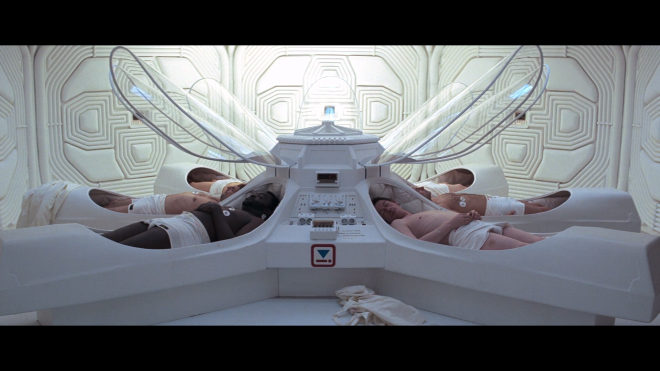
Alien
Simply put, Ridley Scott's Alien arrives on Blu-ray with the same phenomenal 1080p/AVC MPEG-4 encode (2.40:1). The sci-fi horror classic shows incredible detail, far better than anyone could have imagined for a nearly forty-year-old film. We can clearly make out the intricate design of the Nostromo's and the crashed alien spacecraft's interiors. Every distinct line in the metallic, claustrophobic halls, the mess hall, the air shafts, and all the computer gadgetry is made plainly visible. We can even see pores, wrinkles and small defects on the faces of actors while the alien's body reveals the hard work done by the designers. At times, the picture appears as though some digital noise reduction was used to clean it up a bit, but it's very mild and doesn't ruin the movie in any significant way.
The film has always been dark with harsh, oppressive shadows, but delineation remains strong. Contrast is pitch-perfect, and blacks are often intense and deep, much better resolved with clean gradients than on previous editions. There are a couple moments with noticeably weaker resolution which take away from the brightness levels somewhat, like the scene when Kane wakes up in the infirmary. But for the most part, the image is consistent and beautiful. The palette is rather limited since more emphasis is placed on generating a brooding, ominous atmosphere, but the colors we do see, particularly reds, are rendered accurately and vibrantly. There is also another small change in color timing with a slight push on blue, giving the video a steelier, metallic appearance. Again, this is only noticeable if one wishes to carefully examine the differences, which honestly does nothing to spoil the film's enjoyment. All things considered, this high-def transfer of 'Alien' makes a stunning presentation on Blu-ray and remains the horror masterpiece it's always been. (Video Rating: 4.5/5)
Aliens
The classic sequel erupts on Blu-ray with the same somewhat controversial "de-noised" and "de-grained" presentation. But like its predecessor, this 1080p/AVC MPEG-4 encode (1.85:1) looks stunning and spectacular on Blu-ray, exhibiting plenty of natural film grain throughout. The picture shows astounding resolution and clarity in the clothing, weapons and exposes intricate, distinct lines in the architecture of the Hadley's Hope colony. Facial complexions display amazing lifelike definition and texture. Blacks are deep and penetrating, often rich while contrast levels are crisp and precise. The balance is so good, in fact, that early sequences in space can easily serve as demo-material for calibration purposes. Shadow details are also superb and revealing. Colors are deliberately limited, but accurately rendered, especially in the primaries, with strong variation in the palette.
The one major caveat in the entire presentation is also a rather significant change from all previous home-theater releases, something Cameron also mentioned in the interview linked above. Of course, the application of some digital noise reduction and sharpening is a considerable alteration for fans and purists, as it is quite noticeable in a couple scenes. However, it's not obtrusive or distracting enough to ruin the movie. The issue here is with the change in color timing, from warmer redish hues with a strong blue push to an obvious green-teal appearance with orange hues. This is most apparent when characters arrive on LV-426 in Chapter 9 and at the beginning of Chapter 11 when the team walks around the research lab.
Admittedly, since this was scanned from the OCN, it's possible this is how the film was always meant to look and previous home editions are wrong. But it's equally possible James Cameron made the change due to some kind of revisionist mentality many filmmakers are lately suffering from. Whatever the case may be, this is an observable and noteworthy change that fans ought to be aware of. Ultimately, this will come down to personal preference for each viewer (I'm not sure I like it too much myself) given that the color timing revision doesn't completely spoil the picture quality of Aliens. The high-def transfer of this classic sci-fi actioner is still beautiful and remarkable on Blu-ray either way. (Video Rating: 4.5/5)
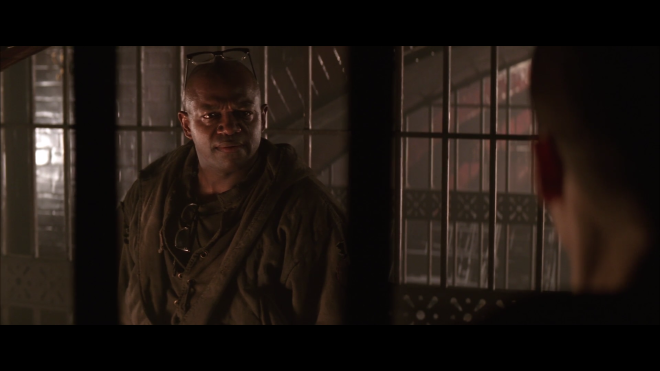
Alien³
Unlike the previous two films, this third installment to the favorite franchise is not all that impressive, despite still being a reasonable upgrade from its standard definition counterpart. Although the 1080p/AVC MPEG-4 encode (2.35:1) shows several moments of softness, the picture often displays really nice details and clarity throughout. The stylized video shows plenty of clear definition in the faces of actors and the prison facility. Contrast is comfortably bright, allowing for great visibility of background info and strong shadow delineation. Black levels are fairly deep and resilient, providing the image an attractive cinematic quality. The color palette is intentionally muted to give the movie a drab and gloomy appearance, but secondary hues are accurate while reds are bold and vibrant. The transfer looks pretty good overall, but several soft spots brings it down a notch. (Video Rating: 3/5)
Alien Resurrection
Like the last video, the third installment doesn't appear to have received the same restoration effort as the first two movies. Don't get me wrong, this 1080p/AVC MPEG-4 encode (2.35:1) is mostly an upgrade from its DVD counterpart, but it's not really a hands-down, decisive winner. Of course, this being a Jean-Pierre Jeunet film, the image is highly stylized with a warm palette that artfully emphasizes secondary hues. Fine object detailing is pretty good and improves during close-up shots. Contrast is nicely balanced while blacks are deep and attractive. However, there are a few instances of crush and questionable shadow delineation. There is also some evidence of sharpening and digital noise reduction in certain scenes, such as at the 14-minute mark of Chapter 6 in the Special Edition cut. We can see plenty of natural film grain throughout most of the movie, but the transfer tends to be rather inconsistent, with several moments of softness. By and large, the stylized picture looks good in high-def, but it never really reaches the quality of the first two discs. (Video Rating: 3/5)
Audio Review

Alien
Scott's Alien is not a film with a whole lot going on sonically, and that's really more by design than any technical limitations. This DTS-HD Master Audio soundtrack appears faithful to that, where silence becomes a terrifying character in and of itself, and doesn't add any artificial effects in the surrounds. Most of the attention is given to the fronts, with well-prioritized vocals and an expansive dynamic range. The other two channels display the discrete, off-screen sounds of the ship accurately and flawlessly, creating a wide and spacious soundstage. Bass is not all that active, but there is a noticeable low-end present throughout, adding good depth and some force to action scenes. Rears are essentially reserved for very light atmospherics and faint echoes that nicely expand the soundfield. Ripley's escape during the self-destruct countdown exhibits the most activity so as to raise the suspense and energy. Jerry Goldsmith's artfully subtle score also makes good use of the back speakers with mild bleeds. This lossless mix of a sci-fi horror classic sounds excellent on Blu-ray. (Audio Rating: 4/5)
Aliens
James Cameron's follow-up to Scott's horror landmark arrives with an excellent DTS-HD Master Audio option which also appears faithful to the movie's original design. This is understandably a front-heavy presentation with great fidelity and acoustical presence. Dialogue reproduction is terrific and precise, even amid the loudest moments. Channel separation and movement feels expansive and convincing, creating a spacious and engaging soundstage. Sharp, room-penetrating dynamics exhibit plenty of clarity detail, keeping things lively and entertaining, while the low-end packs a clean, responsive wallop during explosions. Rears are not always active, but subtle ambient effects are employed on occasion to enhance the soundfield and can envelop the listener satisfyingly. James Horner's musical score receives the biggest upgrade by spreading to the background evenly, adding to the imaging and pulling viewers into the action persuasively. Overall, Aliens sounds terrific on Blu-ray. (Audio Rating: 4/5)
Alien³
The DTS-HD Master Audio soundtrack accompanying the film sounds much better than the movie looks, although it does come with one important issue. Vocals tend to be overwhelmed by sudden bursts of action and music. It can sometimes be very difficult to hear certain conversations. This is a shame seeing as how the rest of the lossless mix sounds great. The front soundstage exhibits imaging that's wide and welcoming with expansive dynamics and sharp acoustics. Low-frequency effects can be quite powerful and broad, but not as responsive or cleanly rendered as I would have liked. Elliot Goldenthal's score fills the entire system with amazing detail and clarity, drawing viewers into the action and story.Rear activity also displays a good amount of ambience and movement, though it never feels wholly convincing or immersive. Nonetheless, Alien³ provides a highly enjoyable lossless mix on Blu-ray, except for some rather weak vocals. (Audio Rating: 3.5/5)
Alien Resurrection
As the newest addition to the franchise, Alien Resurrection comes with the most activity in the surrounds, and this DTS-HD Master Audio soundtrack delivers a fun, action-packed experience. Discrete, off-screen atmospherics create an enjoyable soundscape that's engaging, and movement between the channels is convincing. The scene where everyone emerges from the water into a gunfight is a good moment of immersion. John Frizzell's musical score also spreads into the background with charisma, pulling viewers into the movie. Dynamic range is wide and detailed, providing the soundstage with a nice, welcoming presence. Low bass is punchy and deep, giving each explosion and gunshot some serious impact. Dialogue is well-prioritized and clear, even in the movie's loudest sequences. In the end, Jeunet's film sounds great on high-resolution audio. (Audio Rating: 4/5)
Special Features

The same set of supplements is ported over for this reissue, and it remains one of the most extensive and fully-loaded packages on Blu-ray.
DISC ONE: ALIEN
Audio Commentaries: Two commentaries are available on this disc. First is from the cast and crew which was recorded separately and then edited together, so the entire track can be somewhat choppy and all over the place. Dan O'Bannon and Ron Shusett talk mostly about the story, script and where ideas came from while also throwing in a few compliments about the production. Ridley Scott is given the most time, appearing twice: once by himself; and the other time with Sigourney Weaver. These comments are quite informative and the most entertaining of all. Every now and then, we also hear a few words from John Hurt and editor Terry Rawlings that are scene-specific. The loudest is a group recording with Tom Skerritt, Veronica Cartwright, and Harry Dean Stanton. They really enjoy each other's company and have lots of fun talking.
The second commentary comes from Ridley Scott flying solo this time, and it is a recommended listen for any fan of the film. The director is very enlightening and revealing about the process of making a movie, specifically one with so much creative design meant to terrify audiences. He also provides comments on specific scenes, as well as behind-the-scenes anecdotes on the challenges he faced as a director — only his second feature-length film at the time. The track is unfortunately only available on the Theatrical Version.
Deleted Scenes Index (HD, 7 min): The same seven scenes from previous releases.
Introduction (SD, 1 min): The same short intro from Ridley Scott at the start of the 2003 Special Edition cut of the movie can only be viewed when selecting that version. It's not made available as a separate option in the bonus features.
Deleted Scene Footage Marker: Available since the 2003 version, selecting this option allows the disc to highlight with a small "x" icon on the lower right corner indicating added footage.
Isolated Score.
DISC ONE: ALIENS
Audio Commentary: Similar to the track on the first disc, the commentary features several participants recorded separately and edited together later. James Cameron is by his lonesome and of course, talks heavily about the production, design, and filming techniques. Producer Gale Anne Hurd and special effects wizard Stan Winston discuss issues that arose during shoots and a few comments on the creatures, especially on the Queen. Visual effects supervisors Robert and Dennis Skotak spend their time on specific scenes along with the photography and the film's overall design. Pat McClung is the effects supervisor of miniatures, and his voice is only heard when his work is seen on screen. The last group is the cast Michael Biehn, Lance Henriksen, Bill Paxton, Jenette Goldstein, Carrie Henn, and Christopher Henn. The group may not be as rambunctious as in the first movie, but they definitely have a good time and talk about their time together in great length. The track is available on both versions of the movie.
Deleted Scenes Index (HD, 20 min): The same sixteen scenes from previous releases.
Introduction (SD, 1 min): This is a short intro from James Cameron for the 1990 Special Edition cut where he explains his preference for that version over the theatrical..
Deleted Scene Footage Marker: Available since the 1990 version of the film, selecting this option allows the disc to highlight with a small "x" icon on the lower right corner indicating added footage.
Isolated Score.
DISC ONE: ALIEN³
Audio Commentary: Similar to the track on the first disc, the commentary features several participants recorded separately and edited together later. James Cameron is by his lonesome and of course, talks heavily about the production, design, and filming techniques. Producer Gale Anne Hurd and special effects wizard Stan Winston discuss issues that arose during shoots and a few comments on the creatures, especially on the Queen. Visual effects supervisors Robert and Dennis Skotak spend their time on specific scenes along with the photography and the film's overall design. Pat McClung is the effects supervisor of miniatures, and his voice is only heard when his work is seen on screen. The last group is the cast Michael Biehn, Lance Henriksen, Bill Paxton, Jenette Goldstein, Carrie Henn, and Christopher Henn. The group may not be as rambunctious as in the first movie, but they definitely have a good time and talk about their time together in great length. The track is available on both versions of the movie.
Deleted Scenes Index (HD, 50 min): Thirty-one deleted and extended scenes are collected here which can also be watched integrated into the movie by watching the Workprint Version.
Deleted Scene Footage Marker: Available only on the Workprint Version, selecting this option allows the disc to highlight with a small "x" icon on the lower right corner indicating added footage.
Isolated Score.
DISC ONE: ALIEN RESURRECTION
Audio Commentary: Yet again, this is another commentary track with participants recorded individually and edited together later. Jean-Pierre Jeunet talks about the many creative decisions made throughout the production and explains the several different ideas he had in making this movie. Editor Hervé Schneid and concept artist Sylvain Despretz discuss the many quirky elements of the film, while effects creators Alec Gillis and Tom Woodruff converse with visual effects supervisor Pitof about the design work and make several funny scene-specific comments. Finally, we have Dominique Pinon, Ron Perlman and Leland Orser sharing anecdotes about the production and working with the cast. It's not a bad track, but it's also not a wholly exciting one either.
Deleted Scenes Index (HD, 12 min): The same eleven deleted and extended scenes, which have also been integrated into the 2003 Special Edition cut.
Introduction (SD, 1 min): Same short intro from Jean-Pierre Jeunet for the 2003 Special Edition cut explaining this version is not a Director's Cut and that he's satisfied with the theatrical version.
Deleted Scene Footage Marker: Available Special Edition version of the 'Alien Resurrection,' selecting this option allows the disc to highlight with a small "x" icon on the lower right corner indicating added footage.
Isolated Score.
DISC FIVE: MAKING THE ANTHOLOGY
The Beast Within: Making Alien (SD, 175 min): Broken into nine individually-titled segments which can be watched sequentially or separately (even in MU-TH-UR Mode), this intriguing and highly enjoyable documentary covers pretty much everything there is to know about Alien. Featuring interviews with all the key players, it commences with the plot's origins and writing the screenplay. Dan O'Bannon talks about meeting H.R. Giger on the set of Alejandro Jodorowsky's failed Dune project and the script challenges he was met with in the pre-Star Wars era. Then we move into Ridley Scott's involvement and the attraction he had to Giger's artwork after O'Bannon handed him a copy of the artist's book. Giger is also allowed his thoughts on working with the filmmakers.
With creature and set design at the ready, Scott wisely chose to cast relatively unknown actors, such as Sigourney Weaver making her film-debut. The doc also spends a good amount of time on the all the design work and shooting the film. It's humorous hearing how O'Bannon was intimately involved during this part of the production. There are talks with Terry Rawlings about the difficulties and decisions made in the editing process as well as some cool talks about Jerry Goldsmith's brilliant music. The visual effects portion is also a cool watch with on-set photo stills of conceptual renderings and miniatures. Most interesting, at least for me, is the final piece which focuses on the film's reaction and the public's reaction. The anecdotes about of theater audiences fainting and barfing are funny, and it's amusing to see photos of the long lines and hearing that the movie was a shocking box-office hit. Better still is listening to Dan O'Bannon's tearful reaction and joy. All in all, this is a great making-of documentary.
Alien Enhancement Pods (SD, 80 min): Essentially, this is more or less like a collection of 27 deleted or extended interviews. There are also several scenes which didn't make it into the final cut of The Beast Within. They can all be watched in order or individually. The most interesting pieces are on Jodorowsky's Dune being a major design influence of the sci-fi genre, talks about Giger, and other thoughts from Jerry Goldsmith about the music and film. But above all else, James Cameron is given a couple minutes to freely share his thoughts on Ridley Scott's film.
Superior Firepower: Making Aliens (SD, 186 min): Much like the previous making-of feature, this documentary is an incredibly exhaustive and exceedingly in-depth look at the production surrounding Aliens. Broken into eleven featurettes that can be watched separately or in sequence (or again, in MU-TH-UR Mode), this obviously starts with a few words on Scott's original film and the attempt of living up to that genius. Surprisingly, producer David Giler mentions that they wanted a sequel soon after the success of the first, but there wasn't enough support at the studio. When management changed, suddenly a sequel became a possibility, and after reading the script for Terminator, Cameron was hired to develop a treatment and script. After that turned into a hit, he was later chosen to direct. With the ball finally rolling and Sigourney Weaver attached, Cameron started to film with a desire to make a war film in the Alien theme rather than a cheap imitator or clone.
The rest of the doc then examines some of the concept art developed in preproduction, the actual design of the set along with the alien creature and casting the characters, particularly Bishop, Hicks and Hudson. Viewers are also allowed to enjoy some great behind-the-scenes footage while key crew members discuss issues experienced on the set and working for a stressfully demanding director like Cameron. We even spend some time on the weapons, Ripley and Newt, the Queen alien, the visual effects, and on the postproduction, especially on the music, editing and sound area. We find out how stressful the filming of Aliens really was and the kind of perfectionist Cameron can be. And like the above doc, most interesting is the last piece on the theatrical release and public reaction. After watching this three-hour doc, most will probably feel somewhat like an expert on Aliens and the entire production.
Aliens Enhancement Pods (SD, 59 min): Another collection of what seems like scenes that never made into "Superior Firepower." It starts with producer David Giler revealing that filmmakers actually considered making the sequel without Ripley simply because the role was a woman! The rest cover various areas of the production like Cameron's comments on set design and his interests on the military. There's also some great test footage of the special effects and Stan Winston sharing certain challenges he had to overcome. The more interesting pieces are with talks on the visuals and interviews with Ron Cobb and the cast, especially the comments on Sigourney Weaver and her role as Ripley.
Wreckage and Rage: Making Alien³ (SD, 180 min): Finally, one of the most interesting and revealing documentaries about a heavily troubled production is made available to fans — complete and uncut. Wreckage and Rage is a captivating look at how a movie with so much talent involved can go so completely wrong. The doc is also rather infamous because Fox heavily edited the footage of any negative comments directed at the studio as well as removing huge chunks of scenes where David Fincher and cast openly express their dissatisfaction with the studio. Here, we have the doc in its entirety and I applaud Fox for releasing it as part of the Anthology package.
Before getting into Fincher's bad experience, one very intriguing aspect of this doc is learning more about Vincent Ward's involvement. His original vision and ideas would have also made a fascinating and absorbing film had they committed more to it. Of course, the main attraction in this three-hour presentation is Fincher being hired while in the middle of preproduction, without a completed script and being almost immediately undermined by the powers that be. The shoot itself was also a stressful experience for everyone, but the cast clearly respected the young director and enjoyed working with him. This bleeds easily into "The Downward Spiral" segment where people discuss how heads clashed and how Fincher received a great deal of distrust from the studio and producers but not the cast and crew. And like the other docs, most interesting is the reaction to the finished product.
Alien³ Enhancement Pods (SD, 74 min): This assortment of various interviews is fairly entertaining, especially if one is fascinated by the history of this production. The best segments are, obviously, those associated with Fincher's experience and folks praising his visionary style. Others have actors like Michael Biehn and Lance Henriksen sharing their thoughts on their characters and the third film. There are also some really cool sequences on the make-up and special effects work as well as recording original sounds for this movie and the decision for not using a powerful low-end. I think the best of the bunch are the last two, where Sigourney Weaver talks about Ripley's evolution while cast & crew share their thoughts about the end product.
One Step Beyond: Making Alien Resurrection (SD, 175 min): Following in the same footsteps of the other movies, Resurrection is also given a lengthy and exhaustive documentary which covers pretty much every aspect of its production. Unfortunately, with only a small interest and slight admiration for the movie, watching the whole thing is a bit of a chore and quite tiring. The reason for this is that interviews consist generally of praise for an unworthy sci-fi feature. Probably even weirder is the cast and crew actually believing the whole cloning concept was clever in the first place, and I'm sorry to say no, it is not. Granted, the Ripley character is a significant focal point in the Alien universe, but like so many note, the series should have ended with the previous film as it nicely brings everything to a close.
On a lighter note, however, the doc really tries to be somewhat critical of itself and informative of the creative decisions made. Danny Boyle was, at one point, considered to direct before finally settling with Jean-Pierre Jeunet. What's really funny about all this is hearing everyone extol the French filmmaker as the perfect visionary, then to hear it straight from the horse's mouth his confusion as to why he was asked to direct. The more worthwhile aspects are the segments concerning the actual shoot and the challenges Jeunet had to overcome, like the underwater scene. The other pieces are logically more focused on an entirely new creature design and the use of miniatures versus CGI work. Talks about John Frizzell's music composition are of course interesting, but like the previous three, I like listening to the reaction of how everything comes together in the end.
Alien Resurrection Enhancement Pods (SD, 75 min): Once again, and for the final time, this is a gathering spot for the leftover footage from the documentary. And just as in watching the doc, sitting through each segment is a bit of a task, primarily because interest in the movie is greatly lacking. Still, a few of the pieces are somewhat worthwhile like Bob Ringwood's anecdote on creating Ripley's new look. In fact, to go along these lines, the better segments are the ones focused on the design department since Jeunet does have a unique visual style. The comments on the special effects are also interesting.
DISC SIX: THE ANTHOLOGY ARCHIVES
Alien Pre-Production (SD, HD): In this first section, fans can enjoy a large variety of material surrounding the preproduction of Alien. There's a lengthy note by Dan O'Bannon on the history of the movie as well as a copy of the screenplay he originally wrote. The pre-visualization stage shows concept renderings and note from Ridley Scott, called "Ridleygrams," along with storyboard drawings. There's also a portrait gallery, which are stills of cast in costume, and five screen tests (1 min) of Sigourney Weaver with optional Scott commentary on the first three.
Alien Production (SD, HD): Next, fans can watch the chestbuster scene from different angles (5 min) or the actual footage as seen on the computer screens in the movie (6 min). Afterwards, there is a series of still photographs taken while on the set of the movie, the original Polaroids used for continuity, the set design and H.R. Giger's workshop.
Alien Post-Production and Aftermath (SD, HD): In this section, we have 7 deleted scenes, some re-recorded in 5.1 Surround Sound (17 min), and a fairly large photo gallery on the visual effects, premiere party and posters. Best part is the inclusion of stills ripped from the Laserdisc release as well as the bonus material from other releases, like "Experience in Terror" (7 min) and "The Alien Legacy" (67 min). Finishing this section is "American Cinematheque" (16 min) and a small assortment of theatrical previews and TV spots.
Aliens Pre-Production (SD, HD): If O'Bannon can do it, then why not Cameron. First up in this option is the director's original treatment (text only) for the movie. An optional commentary comes attached to multi-angled view of (3 min). Bringing it all to a close is an extensive still gallery of storyboards, cast portraits, and alien creature designs.
Aliens Production (SD, HD): Most everything here is a gallery of photos showing weapons, vehicles and some taken while on the set. We also have stills of Stan Winston's workshop and the original continuity Polaroids. Best part is the video footage taken from the movie (13 min), like the helmet cameras and the dossiers from the Nostromo.
Aliens Post-Production and Aftermath (SD, HD): This collection also sees the Laserdisc stills and a photo gallery along with a cool montage of the different main titles considered for the opening (3 min). There's also another montage with extended/deleted scenes of dialogue (4 min), and one removed sequence with Burke cocooned (2 min). We also some theatrical previews and a TV spot. Best of all is the introductory video before the simulated thrill ride from Fisherman's Wharf in San Francisco and followed by video of the ride itself (8 min), with Jeffrey Combs!! "Game over, man! Game over!"
Alien³ Pre-Production (HD): All we have here is a lengthy still gallery of storyboards and concept art for the Arceon and Fiorina.
Alien³ Production (HD): This is another still gallery of the production and the special effects workshop. There's also some cool behind-the-scenes footage of the construction of the furnace, shown in time-lapse (5 min), and another multi-angle sequence of the EEV bioscan scene with commentary by Alec Gillis (2 min).
Alien³ Post-Production and Aftermath (SD, HD): Here's yet another still gallery of the visual effects and promotional photos. After that, there are two EPK segments with the making-of promotional video being the longer of the two (24 min). The "Advance" featurette is mostly a walk-through of the set with a short interview of Sigourney Weaver (3 min). Finishing the section is another series of previews and TV spots.
Alien Resurrection Pre-Production (HD, SD): For the fourth film, viewers are offered a copy of Joss Whedon's initial draft of the screenplay. Then, we're given test footage of costumes, hair, make-up and creature design with optional commentary by Alec Gillis (15 min). Next are three different angles (storyboard, rehearsal and final) with two audio options of the scene with Ripley 8 having a medical exam (3 min). Bringing it all to a close is three more still galleries: one for storyboards; one for the characters; and the last for production design.
Alien Resurrection Production (HD): Two simple still galleries of the production and the special effects workshop.
Alien Resurrection Post-Production and Aftermath (HD, SD): Another two galleries of the visual effects and promotional stills start things off. This is followed by the making-of special that aired on HBO First Look (26 min), and then another brief EPK (4 min). Two more theatrical previews and four TV spots finish the section.
Alien Evolution (SD): This is two versions of the made-for-television documentary of the series, hosted by film critic Mark Kermode. The first is a 49-min look at the entire franchise from 2001 with interviews of cast and crew. The second is a re-cut of the first, but focuses more on Ridley Scott's masterpiece with extended interviews, giving it a 65-min runtime. Both retrospective docs are entertaining thanks mostly to Kermode's guiding hand, though many of the comments are the same heard in the other supplements.
The Alien Saga (SD, 109 min): Another made-for-TV documentary from 2002 that looks at the legacy of all four films and hosted by John Hurt. For devoted fans of the series and Scott's original classic, much of the content is already known and feels a bit redundant. The doc spends most of its time on the first movie. Then as it moves into the rest of the series, things remain entertaining with the last few minutes are spent talking about the franchise's impact while conveniently ignoring any issues experience during the production of the third film.
Aliens 3D Attraction (HD): This is a still gallery of storyboards, concept art, and screenplay that was to be used for creating a thrill ride for Everland Theme Park in Korea. It was to be created by the same team that designed Cameron's "T2 3D – Battle Across Time" show.
Aliens in the Basement: the Bob Burn Collection (SD, 17 min): This interview with Bob Burns is simply a look at his extensive collection and a discussion about his obsession with the film franchise.
Parodies (SD, 3 min): These are two short parody scenes that feature the alien queen on Family Guy and the silly ending in Spaceballs where John Hurt reprises his role as Kane.
Still Galleries (HD): Two more and final still galleries brings the entire package to a close. The first is an assortment of cover art for Dark Horse Comics with textual notes, and the second is a collection of patches and logos used throughout the movies in the series.
Final Thoughts
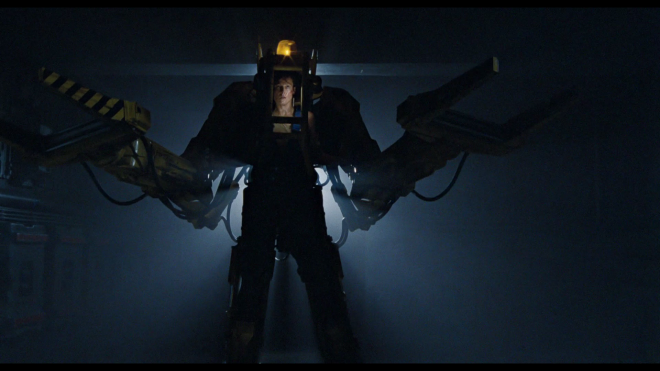
Fox Home Entertainment reissues the same Alien Anthology in a sleek and attractive six-disc box set in preparation for Alien Day and Ridley Scott's upcoming Alien: Covenant. Ridley Scott's initial film remains a sci-fi horror classic, a masterpiece of suspense and terror that could possibly never be topped. The sequel from James Cameron is arguably the best and most impressive follow-up moviegoers have ever seen, delivering a suspenseful thrill-ride of action and adventure. David Fincher's third installment was a troubled production from the very beginning, made worse by the little confidence he was shown by the producers and studio heads. Still, the potential for an amazing film with a great deal of intelligence underneath can be seen in the final product, just never fully realized. The fourth film from French filmmaker Jean-Pierre Jeunet takes a really strange turn for the bizarre and comical, definitely the most outlandish of the series with an even weirder payoff at the end. In the end, the franchise is remembered best for the first two films, as they are the ones which have left the strongest impression.
Ridley Scott's initial film remains a sci-fi horror classic, a masterpiece of suspense and terror that could possibly never be topped. The sequel from James Cameron is arguably the best and most impressive follow-up moviegoers have ever seen, delivering a suspenseful thrill-ride of action and adventure. David Fincher's third installment was a troubled production from the very beginning, made worse by the little confidence he was shown by the producers and studio heads. Still, the potential for an amazing film with a great deal of intelligence underneath can be seen in the final product, just never fully realized. The fourth film from French filmmaker Jean-Pierre Jeunet takes a really strange turn for the bizarre and comical, definitely the most outlandish of the series with an even weirder payoff at the end. In the end, the franchise is remembered best for the first two films, as they are the ones which have left the strongest impression.
This superb Blu-ray edition of all four films is easily one of the most extraordinary packages made available for the home video market. The films by Scott and Cameron display the same absolutely gorgeous high-def video transfers and audio presentations as before. Fincher's and Jeunet's movies also look good and sound better; however, they don't quite match the quality of the first two. The assortment of supplements is one of the most extensive and overwhelming I think I've ever experienced. To top it off, Fox Home Entertainment throws in another exclusive and fancy interactive feature called MU-TH-UR Mode. Seven years later, this remains as one of the largest and most exhaustive Blu-ray packages available, a must own for devoted fans and collectors.


